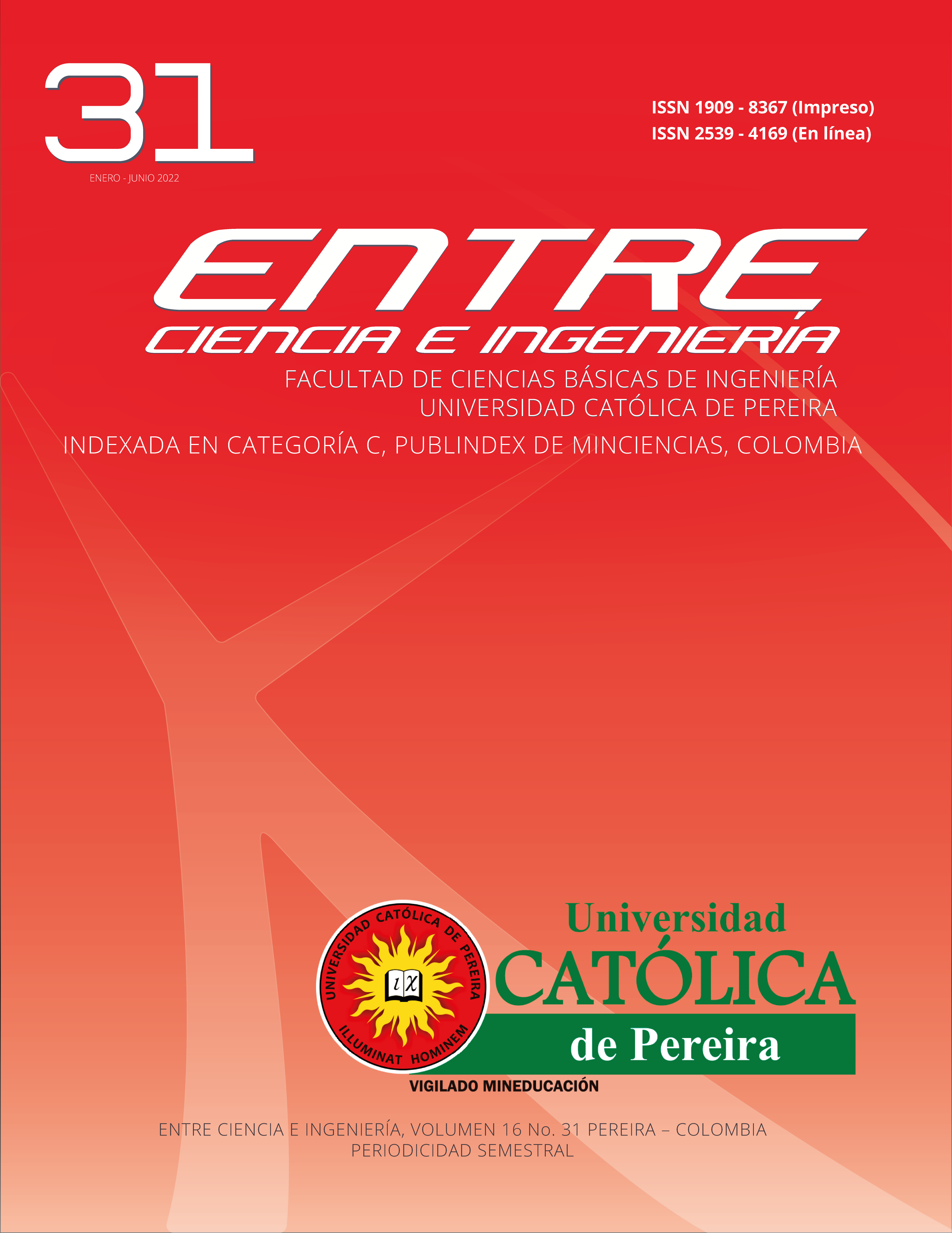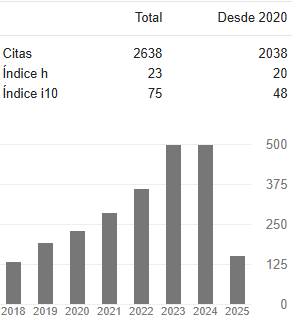Morphologic Analysis of the microstructural affectation of biocomposite material reinforced with fique fiber due to cutting with conventional tool, laser and water jet
DOI:
https://doi.org/10.31908/19098367.2372Keywords:
Morphological analysis, Composite, Water jet cutting, Laser cutting, FiqueAbstract
Thanks to their properties, the use of composite materials in industrial applications has increased in recent decades, especially those with natural fiber reinforcements due to their lower environmental impact; however, one of the great challenges presented by this type of material is to shape them by cutting as their surface integrity can be compromised. In the present work, morphological analysis is carried out on a composite material with fique fiber, evaluating the superficial affectation by cutting made with a conventional tool, laser, and water jet. The material was made with six layers of fique fiber and polyester resin. The morphological study was carried out through scanning electron microscopy, where high defects were evidenced with the conventional tool, an affectation to the matrix in laser cutting, and a low surface impact using the water jet.
Downloads
References
C. Ganesan, P. S. Joanna, and D. Singh, “Fatigue life modeling of FRP composites: A comprehensive review,” Mater. Today Proc., 2021, doi: 10.1016/j.matpr.2020.11.119.
C. Kuo, J. Liu, T. Chang, and S. Ko, “The effects of cutting conditions and tool geometry on mechanics , tool wear and machined surface integrity when routing CFRP composites,” J. Manuf. Process., vol. 64, no. June 2020, pp. 113–129, 2021, doi: 10.1016/j.jmapro.2021.01.011.
C. Pereszlai, N. Geier, D. I. Poór, B. Z. Balázs, and G. Póka, “Drilling fibre reinforced polymer composites ( CFRP and GFRP ): An analysis of the cutting force of the tilted helical,” Compos. Struct., p. 113646, 2021, doi: 10.1016/j.compstruct.2021.113646.
A. Solati, M. Hamedi, and M. Safarabadi, “Comprehensive investigation of surface quality and mechanical properties in CO2 laser drilling of GFRP composites,” Int. J. Adv. Manuf. Technol., vol. 102, 2019, doi: 10.1007/s00170-018-3164-6.
S. Marimuthu, J. Dunleavey, Y. Liu, M. Antar, and B. Smith, “Laser cutting of aluminium-alumina metal matrix composite,” Opt. Laser Technol., vol. 117, no. March, pp. 251–259, 2019, doi: 10.1016/j.optlastec.2019.04.029.
U. A. Kumar, S. M. Alam, and P. Laxminarayana, “Influence of abrasive water jet cutting on glass fibre reinforced polymer (GFRP) composites,” Mater. Today Proc., vol. 27, pp. 1651–1654, 2020, doi: 10.1016/j.matpr.2020.03.554.
F. Masoud, S. M. Sapuan, M. K. A. Mohd Ariffin, Y. Nukman, and E. Bayraktar, “Cutting processes of natural fiber-reinforced polymer composites,” Polymers (Basel)., vol. 12, no. 6, pp. 15–17, 2020, doi: 10.3390/POLYM12061332.
I. A. Choudhury and P. C. Chuan, “Experimental evaluation of laser cut quality of glass fibre reinforced plastic composite,” Opt. Lasers Eng., vol. 51, no. 10, pp. 1125–1132, 2013, doi: 10.1016/j.optlaseng.2013.04.017.
P. Patel, S. Sheth, and T. Patel, “Experimental Analysis and ANN Modelling of HAZ in Laser Cutting of Glass Fibre Reinforced Plastic Composites,” Procedia Technol., vol. 23, pp. 406–413, 2016, doi: 10.1016/j.protcy.2016.03.044.
K. Ramraji, K. Rajkumar, M. Dhananchezian, and P. Sabarinathan, “Key Experimental Investigations of cutting dimensionality by Abrasive Water Jet Machining on Basalt Fiber/Fly ash Reinforced Polymer Composite,” Mater. Today Proc., vol. 22, pp. 1351–1359, 2019, doi: 10.1016/j.matpr.2020.01.428.
D. R. Tripathi, K. H. Vachhani, S. Kumari, Dinbandhu, and K. Abhishek, “Experimental investigation on material removal rate during abrasive water jet machining of GFRP composites,” Mater. Today Proc., vol. 26, pp. 1389–1392, 2019, doi: 10.1016/j.matpr.2020.02.280.
D. P. Navia and N. Bejarano, “Evaluación de propiedades físicas de bioplásticos termo-comprimidos elaborados co harina de yuca,” Rev. del Inst. Nac. Hig. Rafael Rangel, vol. 12, pp. 40–48, 2014.
G. R. Altoé, P. A. Netto, M. Barcelos, A. Gomes, F. M. Margem, and S. N. Monteiro, “Bending mechanical behavior of polyester matrix reinforced with fique fiber,” Charact. Miner. Met. Mater. 2015, pp. 117–121, 2016, doi: 10.1007/978-3-319-48191-3_14.
P. Gañán and I. Mondragon, “Thermal and degradation behavior of fique fiber reinforced thermoplastic matrix composites,” J. Therm. Anal. Calorim., vol. 73, no. 3, pp. 783–795, 2003, doi: 10.1023/A:1025830430267.
M. S. Oliveira et al., “Statistical analysis of notch toughness of epoxy matrix composites reinforced with fique fabric,” J. Mater. Res. Technol., vol. 8, no. 6, pp. 6051–6057, 2019, doi: 10.1016/j.jmrt.2019.09.079.
S. Gómez, B. Ramón, and R. Guzman, “Comparative study of the mechanical and vibratory properties of a composite reinforced with fique fibers versus a composite with E-glass fibers,” Rev. UIS Ing., vol. 17, no. 1, pp. 43–50, 2018, doi: https://doi.org/10.18273/revuin.v17n1-2018004.
A. Díaz-Álvarez, Á. Rubio-López, C. Santiuste, and M. H. Miguélez, “Experimental analysis of drilling induced damage in biocomposites,” Text. Res. J., vol. 88, no. 22, pp. 2544–2558, 2018, doi: 10.1177/0040517517725118.
T. B. Yallew, P. Kumar, and I. Singh, “A study about hole making in woven jute fabric-reinforced polymer composites,” Proc. Inst. Mech. Eng. Part L J. Mater. Des. Appl., vol. 230, no. 4, pp. 888–898, 2016, doi: 10.1177/1464420715587750.
H. R. Maleki, M. Hamedi, M. Kubouchi, and Y. Arao, “Experimental investigation on drilling of natural flax fiber-reinforced composites,” Mater. Manuf. Process., vol. 34, no. 3, pp. 283–292, 2019, doi: 10.1080/10426914.2018.1532584.
N. Venkateshwaran and A. ElayaPerumal, “Hole quality evaluation of natural fiber composite using image analysis technique,” J. Reinf. Plast. Compos., vol. 32, no. 16, pp. 1188–1197, 2013, doi: 10.1177/0731684413486847.
G. D. Babu, K. Babu, and U. M. Gowd, “Effect of Machining Parameters on Milled Natural Fiber-Reinforced Plastic Composites,” J. Adv. Mech. Eng., vol. 1, pp. 1–12, 2013, doi: 10.7726/jame.2013.1001.
A. Riveiro et al., “Experimental study on the CO 2 laser cutting of carbon fiber reinforced plastic composite,” Compos. Part A Appl. Sci. Manuf., vol. 43, no. 8, pp. 1400–1409, 2012, doi: 10.1016/j.compositesa.2012.02.012.
C. Pérez-Salinas, M. Riera, and C. Tonato, “Estudio experimental sobre el corte con láser de CO2 a baja potencia del compuesto de plástico reforzado con fibras naturales,” Enfoque UTE, vol. 11, no. 3, pp. 55–68, 2020, doi: 10.29019/enfoqueute.v11n3.572.
M. El-Hofy and H. El-Hofy, “Laser Beam Machining of CFRP Composites: A Review,” Int. J. Adv. Manuf. Technol., 2019, doi: 10.1007/s00170-018-2978-6.
R. Vinayagamoorthy and T. Rajmohan, “Machining and its challenges on bio-fibre reinforced plastics: A critical review,” J. Reinf. Plast. Compos., vol. 37, no. 16, pp. 1037–1050, 2018, doi: 10.1177/0731684418778356.
A. Dhanawade and S. Kumar, “Experimental study of delamination and kerf geometry of carbon epoxy composite machined by abrasive water jet,” J. Compos. Mater., vol. 51, no. 24, pp. 3373–3390, 2017, doi: 10.1177/0021998316688950.
K. R. Sumesh, K. Kanthavel, and V. Kavimani, “Machinability of hybrid natural fiber reinforced composites with cellulose micro filler incorporation,” J. Compos. Mater., vol. 54, no. 24, pp. 3655–3671, 2020, doi: 10.1177/0021998320918020.
V. A. Prabu, S. T. Kumaran, and M. Uthayakumar, “Performance Evaluation of Abrasive Water Jet Machining on Banana Fiber Reinforced Polyester Composite,” J. Nat. Fibers, vol. 14, no. 3, pp. 450–457, 2017, doi: 10.1080/15440478.2016.1212768.
K. Ramesha, N. Santhosh, K. Kiran, N. Manjunath, and H. Naresh, “Effect of the Process Parameters on Machining of GFRP Composites for Different Conditions of Abrasive Water Suspension Jet Machining,” Arab. J. Sci. Eng., vol. 44, no. 9, pp. 7933–7943, 2019, doi: 10.1007/s13369-019-03973-w.
Downloads
Published
Issue
Section
License
Copyright (c) 2022 Entre ciencia e ingeniería

This work is licensed under a Creative Commons Attribution-NonCommercial 4.0 International License.



















